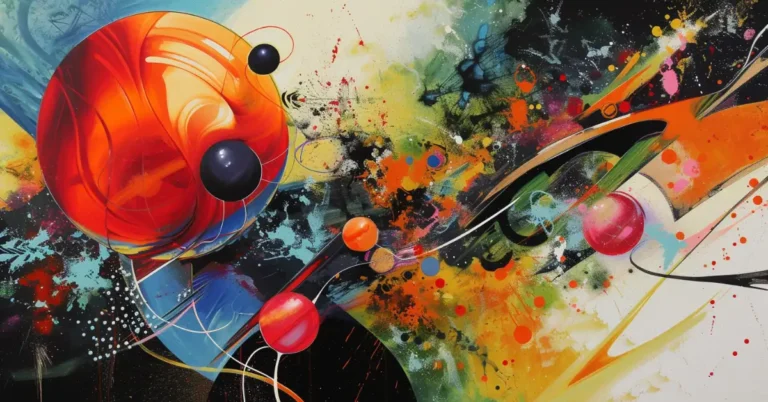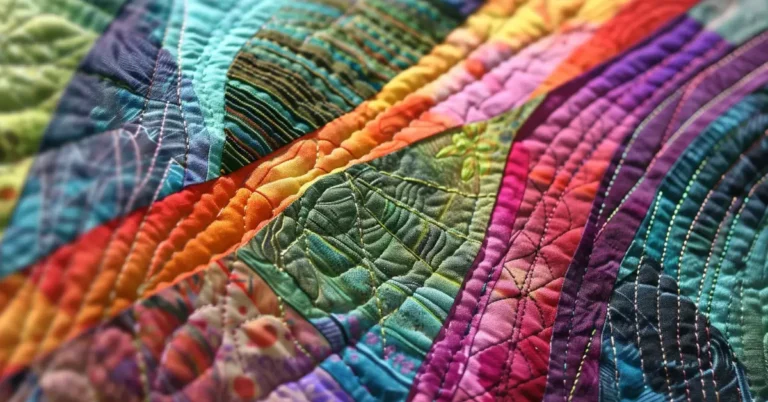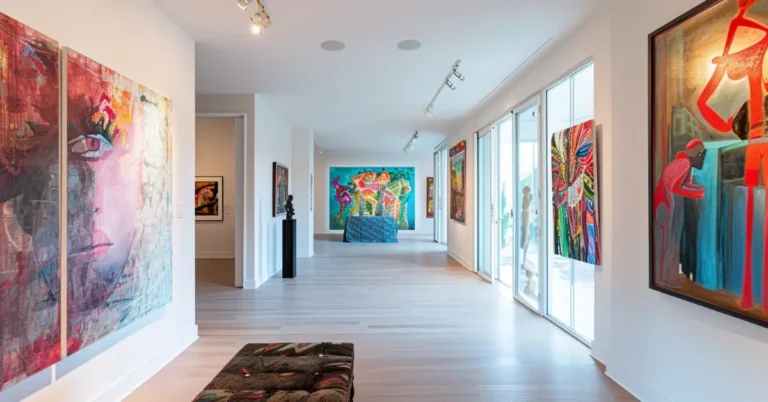Dive into the vibrant heart of Contemporary Japanese Art, where the mesmerizing dots of Yayoi Kusama meet Takashi Murakami’s kaleidoscopic universe, and tradition waltzes with cutting-edge innovation. Japanese artists are redefining the global art scene, skillfully weaving the rich tapestry of their heritage with audacious modernity.
Pros:
✅High Definition Picture Photo Prints on Canvas
✅Perfect suit to all places
✅Ideal as a Gift
Cons:
❌Special color, please check it matches your environment
Contemporary Japanese Art
Historical Context of Japanese Art
Contemporary Japanese art boasts a riveting history that paves the way for the vibrant scene of contemporary Japanese art we celebrate today. With deep traditional roots and dynamic Western influences, this sector has undergone a transformative journey from the Edo period to modern day.
Contemporary Japanese art is a remarkable blend of tradition and innovation, with artists like Yayoi Kusama and Takashi Murakami leading the charge on the global stage. Their works, along with those of other Japanese artists, challenge us to see the world through a lens that respects the past while boldly embracing the future. This dynamic art form, ranging from the Superflat movement to interactive digital installations, not only reflects our collective experiences but also propels us toward new horizons of artistic expression.
Traditional Roots and Evolution
Traditional Japanese art encompasses a variety of mediums and styles, including the intricate woodblock prints of the Edo period and the delicate brush strokes of Japanese painting. Ukiyo-e, characterized by its vivid depiction of daily life, entertainment, and landscapes, was not only popular within Japan but also significantly influenced Western art in the 19th century. The reverence for nature and the emphasis on craftsmanship seen in traditional Japanese art laid the groundwork for future artistic endeavors.
Influence of Western Art
As Japan opened up to the world during the Meiji Restoration, Western art began to weave into the fabric of Japanese aesthetics. This period marks the introduction of Western Art into Japan, making way for the birth of Nihonga—a term that refers to artworks made by traditional Japanese artistic conventions, yet often incorporating Western techniques. Japanese artists began to experiment with new materials and perspectives, enriching the country’s artistic heritage.
From Modern to Contemporary Japanese Art
Transitioning from late 19th-century modern Japanese art, the 20th century saw an explosive shift with artists breaking from convention to embrace global modernism and, eventually, postmodernism. The 1990s in particular heralded a new era in contemporary Japanese art, introducing the world to innovative icons such as Takashi Murakami and Yoshitomo Nara. This era reflects an amalgamation of Japan’s storied artistic past as it intersects with the global art landscape—painting a picture of Japan’s ever-evolving cultural identity.

Kawase Hasui, The Great Buddha – Kamakura 1930, Woodblock Print
Key Movements and Styles
As we dive into contemporary Japanese art, we’re greeted by a rich tapestry of styles that have left their mark on the world. Movements like Superflat and Neo-Pop encapsulate Japan’s unique blend of traditional aesthetics, modern innovation, and compelling global influence.
The Emergence of Superflat
Superflat is more than just a style; it embodies Japan’s post-war creative explosion which intertwines anime and manga elements with fine art. This movement was coined by artist Takashi Murakami, and it unfurls across various mediums, portraying the kawaii culture adored by many. Flatness in Superflat art is both literal and metaphorical, often commenting on consumerism and the shallowness of contemporary culture.
From Mono-Ha to Neo-Pop
Mono-Ha, or the “School of Things,” centered around exploring natural and industrial materials, giving us new perspectives on the interactivity of space, matter, and perception. Pioneers of Mono-Ha set the conceptual stage for what would become known as Japanese Neo-Pop. As Contemporary japanese art evolved, figures like Yoshitomo Nara advanced the narrative, infusing it with pop culture references and a distinctive edge that spoke to the complexities of society. These styles, particularly Neo-Pop, serve as a reflection on Japan’s collective consciousness post-war and its ongoing experimentation within the global art scene.
Thematic Exploration in Art
When we delve into contemporary Japanese art, we immediately encounter the profound layers that tackle various facets of human existence. In our exploration, we find themes that reflect our collective identity, memory, and the societal forces that shape them, drawing on the complexities of race, gender, and globalization among others.

Identity and Memory
Exploring individual and family narratives, artists convey the rich tapestry of memory and identity. We observe a reflection of community and individual experiences, capturing the essence of emotions that define personal histories. The art serves as a vessel, transporting us through the annals of time, highlighting racial and gender disparities, and allowing us to experience the psychological tension and anxiety intertwined with memory.
Society and Consumer Culture
Moreover, contemporary Japanese art often critiques the implications of consumer culture and globalization. In a striking display, artists juxtapose traditional norms against the whirlwind of modern consumerism, creating a visual dialogue about our societal values and the pressures that come with them. The tension between the past and present is palpable as artists question the influence of global consumer trends on the fabric of Japanese identity.
The Expansion of Mediums
Our journey through contemporary Japanese art uncovers an ever-evolving landscape that fascinates and challenges us. The mediums are expanding, disciplines blending, and the traditional boundaries are continuously being pushed, creating an immersive and diverse experience that is as innovative as it is profound.

Installations and Sculptures
In recent years, we’ve seen the rise of installation art that transforms spaces into experiential realms. Japanese artists deftly weave fine art with surrealism, inviting us to step into large-scale installations that are often the highlight of exhibitions around the globe, including the revered Venice Biennale. These aren’t just static pieces; they are worlds unto themselves, from Yayoi Kusama’s mirrored rooms to Tatsuo Miyajima’s LED environments. Sculptures have also seen a shift, driven by a blend of traditional techniques and modern perspectives to invoke a dialogue between the old and the new.
- Notable Mediums: Stone, Metal, Light, Found objects
- Key Themes: Nature, Technology, Urban life, Identity
Digital and Interactive Art
The zest for the digital front is palpable in our era, with Japanese creators at the forefront of digital and interactive art. Embracing technology, artists like teamLab create luminous fields that respond to our presence, crafting experiences that are both cutting-edge and deeply human. This is where art history meets science fiction, culminating in breathtaking exhibitions that are not just seen but felt. Performance art evolves into a multi-sensory journey, turning spectators into active participants.
- Engagement Forms: Touch, Movement, Sound
- Technological Elements: Projections, Sensors, Augmented Reality
Through these mediums, contemporary Japanese art doesn’t just reflect our times; it leads us into the future.
Prominent Contemporary Artists
We’ve witnessed a remarkable evolution in contemporary Japanese art that has placed it on the global stage. From the innovative visions of Takashi Murakami to the profound installations of Chiharu Shiota, these artists have touched the lives of many with their unique perspectives and transcendent works.

International Icons
Yayoi Kusama, known for her immersive polka dot-filled spaces, is a name synonymous with contemporary Japanese art. Her work transcends cultural boundaries and often explores themes of infinity and self-image. Kusama’s exhibitions are known worldwide and continue to attract audiences in the thousands.
Takashi Murakami is another giant within this realm, whose work blurs the lines between fine art and commercial production. His brainchild, Kaikai Kiki Co., Ltd., has been instrumental in the propagation of the Superflat movement, which merges pop culture with traditional Japanese art.
Yoshitomo Nara channels a rebellious spirit through his deceptively simple, childlike figures that convey deep emotional undertones. Often stirring a sense of nostalgia, his art resonates with a wide audience, making him a staple in many international art collections.
Rising Stars in Japan
Among the newer voices from Japan, Chiho Aoshima deserves mention. Aoshima’s fantastical urban panoramas and mythical creatures represent a bridge between fantasy and reality, conveying narrative depth in her digital artworks.
Aya Takano, another artist under the Kaikai Kiki umbrella, brings to life ethereal characters and outer-space themes with a delicate and sensual touch that suggests a future wherein humanity and the universe meet.
Mariko Mori stands out with her use of technology and multimedia to create serenely futuristic installations that question our connection with nature and the cosmos.
Artists like Tatsuo Miyajima, who plays with LED numbers to contemplate human existence, and Yasumasa Morimura, renowned for his photographic reinterpretations of classic paintings, also carve their names into the heart of contemporary Japanese art with their bold and reflective artworks.
FAQ
What are the modern art styles in Japan?
Modern Japanese art styles include the Sosaku Hanga movement, Conceptual Art, and the Superflat movement, which merges pop art aesthetics with kawaii culture.
What type of art is most popular in Japan?
The most popular art forms in Japan include shodo (calligraphy), ikebana (flower arranging), and ukiyo-e (woodblock prints).
How has Japanese art changed over time?
Japanese art evolved from Jōmon pottery to Yayoi metalwork, classical Hokusai paintings, and contemporary movements reflecting Western influences and modern global trends.
What is arigami?
Origami is the traditional Japanese art of paper folding to create both two-dimensional and three-dimensional figures without cutting or gluing the paper.
Enjoyed our blog post on “Contemporary Japanese Art“? We’d love to hear your thoughts! Drop a comment below to share your experience with the article.
If you want to keep reading more from us, have a look at these articles.






